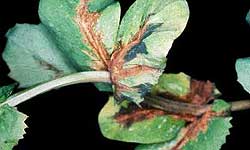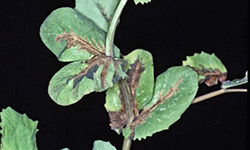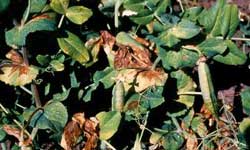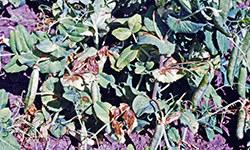Bacterial blight of field peas
Bacterial blight is a serious disease of field peas that is caused by the pathogens Pseudomonas syringae pv. pisi and Pseudomonas syringae pv. syringae. It can be controlled by crop rotation, time of sowing, farm hygiene, sowing disease free seed and using resistant varieties.
What to look for


The disease first becomes evident as small, dark-green, water-soaked lesions on leaves and stipules. The lesions may enlarge and coalesce, but are always delimited by the veins and develop a characteristic fan shape.
The lesions on the leaflets turn yellowish and later brown and papery, lesions on the pods are sunken and turn olive-brown.
Lesions may also develop on stems near ground level. These begin as water-soaked areas, which later turn olive-green to dark brown. Stem lesions may coalesce, causing the stem to shrivel and die. Stem infection may spread upwards to the stipules and leaflets.
Pre-emergence and post-emergence damping-off may occur, and even advanced plants may be killed. Heavily infected seed may be discoloured, but light infection has no visible effect on seed.


The symptoms of bacterial blight caused by Pseudomonas syringae pv. pisi or Pseudomonas syringae pv. syringae are indistinguishable from each other on the pea plant.
Disease cycle
Both bacteria can survive on seed or pea trash, whilst P. syringae pv. syringae can survive on a variety of host plants.
The disease commonly becomes established within a field by sowing infected seed. During wet weather, bacteria spread from infected to healthy plants by rain-splash, wind-borne water droplets and plant to plant contact.
Infection may occur at any stage of plant growth and is most prevalent following frosts. Plants damaged by frosts or any other physical damage are more susceptible to infection.
Rainfall, heavy dews, strong winds and cold temperatures provide the most favourable conditions for spread of disease within crops.
Economic importance
Bacterial blight is widespread in field peas in Victoria but its severity varies greatly from crop to crop and between seasons. Severe epidemics can result in crop failure but losses are usually less than 20%.
The disease can restrict exports as some countries will only import field pea seed from regions where bacterial blight does not occur.
Management
Bacterial blight can be avoided by using an integrated approach to management that encompasses:
- planting disease-free seed
- crop rotation
- variety selection
- avoiding early sowing.
Varieties
Field pea varieties vary in their susceptibility to bacterial blight. All local varieties are susceptible to Pseudomonas syringae pv. pisi, but the frequency of bacterial blight can be reduced by avoiding varieties most susceptible to Pseudomonas syringae pv. syringae.
For further information on disease ratings refer to the Victorian Pulse Disease Guide.
Seed selection
The use of disease free seed is the main control measure recommended.
The use of clean seed will minimise the possibility of disease, provided the land has not been cropped to peas for several years.
Do not use seed from crops found to have bacterial blight during field inspections. A field inspection should occur at mid to late pod fill. Bacteria can remain viable on seed for at least 2 years.
Seed testing for bacterial blight is available from:
- Crop Health Services, Agriculture Victoria, (03) 9032 7515
- DDLS Specimen Reception, DPIRD, (08) 9638 3351, DDLS@dpird.wa.gov.au
Paddock selection
To obtain a blight-free crop, peas should not be sown on land sown to peas in the previous year or adjacent to pea stubble. Where possible, peas should not be grown on the same land more than once in three years.
If disease occurs, the rotation should be extended to once in four years.
Stubble can be a significant source of inoculum. Destroy by burying, baling or burning infected stubble. The survival time of inoculum is significantly reduced by burying pea trash at least 10cm below the soil surface.
Avoid paddocks where sulfonylurea residues may be present and paddocks which are prone to frost.
Time of sowing
Early sown crops are more vulnerable to bacterial blight infection than late sown crops. Never sow earlier than recommended for your district. In areas prone to bacterial blight avoid early sowing.
Foliar Fungicides
Fungicides and seed treatments are designed to be active against fungal diseases and are ineffective in the control of bacterial diseases.
There are copper based compounds that are registered for use in field peas against bacterial blight, but evidence for their effectiveness in Australian field pea crops is limited and inconclusive.
Farm hygiene
When bacterial blight is detected, steps should be taken to prevent the spread of disease.
To avoid contaminating healthy crops, machinery used in an infected crop should be cleaned thoroughly and washed with disinfectant after use.
Likewise, machine operators and farm workers should only move from crop to crop after taking precautions against the spread of bacteria. This is best achieved by wearing rubber boots and waterproof trousers that are washed with disinfectant immediately after leaving an infected field.
Crops should never be inspected when they are wet as this increases the chance of spreading disease.
Where possible harvest infected crops last.
Further references
Detailed information on each of the pulse diseases can be obtained from:
- Pulse Australia
- National Variety Trials
- Field Pea Southern Region - GrowNotes
- Victorian Winter Crop Summary
- Victorian Pulse Disease Guide
- Seed Health Testing in Pulse Crops
- Pulse Seed Treatments and Foliar Fungicides
Contact
Dr Joshua Fanning
Pulse Pathologist — Horsham
0419 272 075
Field Crops Pathology
Grains Innovation Park
110 Natimuk Rd
Horsham 3400
(03) 4344 3111
Or call the Customer Service Centre, 136 186
Acknowledgments
Trevor Bretag, Luise Sigel and Helen Richardson. Support by the Grains Research Development Corporation is gratefully acknowledged.